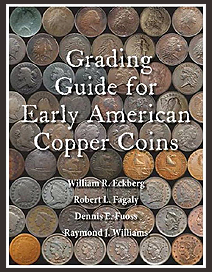Finally there is a coin grading guide written by collectors of Early American Copper for collectors of Early American Copper. This recently published 192 page hard cover book describes and illustrates how to grade Confederation era Colonial coins, as well as U.S. half cents and large cents, using the standards evolved by members of the Early American Coppers club. The authors, members of Early American Coppers and the Colonial Coin Collectors Club, have maintained traditional grading standards while the commercial standards of most of American numismatics have eased to the point where collectors of an earlier generation would not recognize them.
Copper coins were the money of the people and, unlike gold coins, were heavily used in commerce. Because copper coins are heavy and soft, and because copper is more reactive to oxidation than silver or gold, they received more wear and damage than early gold and silver coins. Because their relative value did not fluctuate like that of gold and silver coins, they were less subject to mass melting during their time of circulation. Thus, many stayed in circulation until they were unrecognizable due to wear or corrosion. Yet, because these coins were the money of the fledgling United States, and because the insults that plagued them add to their charm, the collectors of early copper are among the most dedicated and involved in all of numismatics. Nevertheless, the different grading standards early copper specialists use, and the different way that they account for damage, has added an extra level of complexity and concern for those who might wish to collect these endlessly fascinating coins. This book is an attempt to address that complexity and concern by thoroughly describing the grading standards and processes used by specialists in the field and comparing them to the commercial and market grading standards and processes used in the rest of numismatics. We hope this will make copper collecting easier, more enjoyable, and more fulfilling for all.
Chapters in this new grading guide are devoted to sharpness grading for each of the various series, net grading (as practiced within EAC), specific characteristics of many die varieties, comparisons between commercial grades and EAC grades, authentication, the history of coin grading, and discussion of the many factors that can influence the price of a copper coin.
The volume is profusely illustrated with vibrant color images. It should provide both entertaining reading, and a valuable reference for any numismatic library.
“At last! The mystery of EAC grading, that arcane process used by alleged “copper weenies” and the dealers who love them, is finally revealed. This comprehensive, profusely-illustrated guide presents the what, the why, and – most important – the how of EAC grading, detailed by type, date and even die variety. Of particular interest is a textual and pictorial comparison with grading by PCGS and NGC. This long-awaited book is immediately an indispensable reference for anyone interested in the early copper coins of the United States.”
— Denis Loring
“Where was this book when I needed it over 50 years ago? It would have saved me from so many bad decisions when buying early coppers.”
— J. R. (Bob) Grellman, Jr.
“The authors of the Grading Guide for Early American Copper Coins have accomplished what I never could. They explain EAC style grading for half cents and large cents, and even include Colonial coins. Not only do they explain EAC style grading, they teach the reader how to grade by those standards. Every early copper collector needs to understand EAC grading. Every early copper collector needs this book.”
— Mark Borckardt
“I have been following the evolution of EAC grading for many years. I congratulate the authors for their discussion of issues such as luster, porosity, and the importance of various defects at various grade levels. Taken together, these considerations yield an EAC grade that represents old-time conservatism and tradition.”
— Q. David Bowers
“An insightful and incredibly useful guide for anyone who wants to learn how to grade copper coinage like a specialist. It’s about time that someone finally wrote this book. Impressive!”
— James L. Halperin
“A major contribution of this volume is that it provides standardization with color photography and the judicious selection of those coins which best illustrate the technical EAC grades for every early copper design. Even more important are the dozens of photographs of where EAC damage evaluation is applied: the essence of ‘net grading.'”
— Bim Gander

